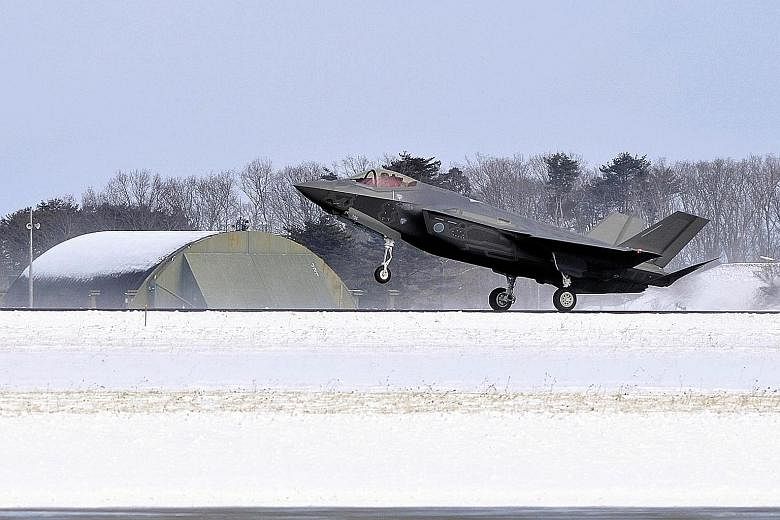Japan plans to have an aircraft carrier for the first time since World War II, a move that has raised eyebrows even though Tokyo insists it will not mark any shift from its pacifist defence posture.
The plan to modify at least one of its two Izumo-class helicopter destroyers such that it can launch a variant of the stealth F-35 fighter jet will be crystallised in new defence guidelines to be approved by the Cabinet next week, media reports have said.
Other plans reportedly in the guidelines, which will cover five years from April next year, include the purchase of 105 F-35 jets from the United States to replace an ageing fleet of F-15s, and the deployment of unmanned surveillance submarines, as well as long-range and hypersonic missiles to defend its small islands, including the Okinawa chain.
The 105 jets will include 42 F-35B aircraft, which have short take-off and vertical landing capabilities and have not yet been deployed in Japan. Tokyo hopes the big-ticket purchase - which contributes to a record 27.5 trillion yen (S$333 billion) five-year defence budget - will go some ways in mollifying US President Donald Trump, who has pilloried Japan, a key security ally, for its huge trade surplus.
Japanese analysts told The Straits Times that the new measures signal heightened concerns over a hostile security environment, marked by increasing Chinese and Russian military presence in waters around Japan, the stymied progress of North Korea's denuclearisation and emerging cross-domain threats.
But much attention is being paid, however, to the proposed upgrades to the Izumo as its new-found offensive capability will go well beyond that of self-defence and despite a pacifist Constitution, which Prime Minister Shinzo Abe has vowed to amend by 2020.
Japan's two Izumo-class vessels, named Izumo and Kaga, are its largest destroyers at 248m in length and 27,000 tonnes in weight. They are each now capable of carrying 14 helicopters, though, when modified, will be able to carry the F-35B variant.
Kyodo news agency, citing a passage from the guidelines, reported that the upgrade will "enable fighter jets to be operated from existing warships, if necessary, to improve the flexibility of their operation".
Dr Narushige Michishita from Japan's National Graduate Institute for Policy Studies told The Straits Times the upgrade will be an important step, despite limits to how the Izumo can be modified that will in turn "limit the operational radius of any fighter aircraft".
Nonetheless, the modification will enable the Izumo to be a more all-round carrier that can "operate in a much more hostile environment than before, therefore enhancing its value as an anti-submarine warfare platform while building on its air defence capability", he added.
Kobe University security expert Tosh Minohara said the upgrade will boost Japan's power projection. He said: "As the old adage goes, the best defence is a good offence, which in this case is the deterrence effect."
Defence Minister Takeshi Iwaya has stressed that Japan will not label an upgraded Izumo as an "attack aircraft carrier", and that it will not pose any threat to other countries, even if fighter jets were to be deployed.
China's Global Times newspaper, however, slammed the plan, accusing Japan of resorting to the "China threat theory as an excuse to do what it wants".
Japan offers to sell air defence radar to the Philippines
TOKYO • Japan has offered to sell an air defence system to the Philippines in a deal which, if sealed, would be the first time Tokyo is exporting military equipment since a 50-year ban was lifted in 2014.
Philippine Defence Secretary Delfin Lorenzana confirmed the sales pitch on Thursday when he told reporters that it was "one of the platforms being evaluated by the Philippine Air Force".
Japan's Nikkei daily, which first reported the story last week, said Tokyo was offering an upgraded model of the Mitsubishi Electric FPS-3 air defence radar system to Manila for between one billion and two billion yen (S$12.1 million to S$24.2 million).
The Philippine government is due to make a decision early next year on the acquisition of the equipment, which will be used to monitor aircraft and vessels in its territory.
Japan sees the Philippines as a key security partner as a counterweight to China's assertiveness in the South China Sea. It has extended capacity-building assistance and taken part in military exchanges with Manila.
Japanese armoured vehicles were involved in a joint military exercise with US and Filipino troops in October, the first time they had been deployed on foreign soil since World War II.
Japanese Prime Minister Shinzo Abe, while bound by a pacifist Constitution, has sought to pursue a more muscular security agenda.
The lifting of the ban on arms exports followed his vision of "proactive contribution to peace", which, he said, could lead to Japan benefiting from an improved security environment due to its own international outreach.
Kobe University security expert Tosh Minohara told The Straits Times: "By exporting arms, Japan can advance its military ties with other countries beyond just overseas development assistance. This can lead to more interactions and more dialogue."

